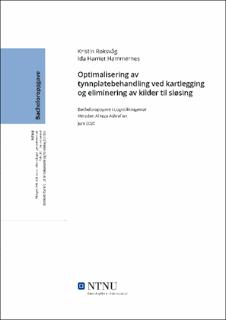| dc.contributor.advisor | Ashrafian, Alireza | |
| dc.contributor.author | Roksvåg, Kristin | |
| dc.contributor.author | Hammernes, Ida Harriet | |
| dc.date.accessioned | 2020-07-02T16:01:09Z | |
| dc.date.available | 2020-07-02T16:01:09Z | |
| dc.date.issued | 2020 | |
| dc.identifier.uri | https://hdl.handle.net/11250/2660594 | |
| dc.description.abstract | Tynnplatebehandling er en populær behandlingsteknikk som krever god planlegging. Denne studien er et samarbeid med Sifa, som er en produksjonsbedrift som prosesserer og sammenstiller tynnplater. Sifa er en ledende bedrift innen denne bransjen, men har likevel forbedringspotensial på flere områder innad i bedriften. På forespørsel fra daglig leder, Arnt Otnes, var det ønskelig å avdekke tidstyver som svekker produksjon- og informasjonsflyten. Denne studien baserer seg derfor på tidstyver internt i Sifa og hvordan disse kan elimineres for å oppnå økt konkurransedyktighet. Studien vil besvare problemstillingen «Avdekke og eliminere tidstyver ved hjelp av lean metodikker for å optimalisere material-, informasjon- og produksjonsflyt i Sifa». For å besvare problemstillingen har det blitt utarbeidet tre forskningsspørsmål.
Problemstillingen har blitt besvart gjennom et kvalitativt studie, hvor casestudie har blitt benyttet. Ved innhenting av data og informasjon ble semistrukturerte intervjuer benyttet som forskningsdesign. Det teoretiske rammeverket belyser i hovedsak lean og lean metodikker og benyttes for å skape et nyansert bilde av de kartlagte problemområdene.
Våre funn tyder på at bedriften hadde et mislykket implementeringsforsøk av lean i 2014. Den største årsaken til at dette mislyktes viste seg å være at lean kun ble implementert i deler av bedriften. Videre analyse identifiserte opp til flere tidstyver som påvirker både material-, informasjon- og produksjonsflyten. Et lyspunkt i dette er at ledelsen virker å være motiverte til å ta tak i de problemområdene som har blitt avdekket, noe som kan resultere i at et nytt implementeringsforsøk av lean kan lykkes. Avslutningsvis tyder våre funn på at det er viktig med involvering av medarbeidere for å oppnå en kultur for kontinuerlig forbedring. | |
| dc.description.abstract | Sheet metal processing is a popular machining technique that requires excellent production planning. This in-depth study is a collaboration with Sifa, a production company that processes and assembles sheet metals. Sifa is a leading company in the sheet metal industry, but nevertheless there is several aspects and areas within the company that still has potential for improvement. At the request of the Managing Director of Sifa, Arnt Otnes, it was expressed an interest for uncovering sources of waste that impair the flow of both manufacturing and information. Here, special emphasis were placed on identifying sources of waste connected to time and inefficiency. Therefore, this thesis is based on sources of waste within the organization’s internal procedures, and how these can be eliminated to achieve increased competitiveness. The study will answer the following thesis statement “Identifying and eliminating sources of waste using lean methodologies to optimize flow of material, manufacturing and information in Sifa”. Three research questions were developed to profoundly answer the thesis statement.
The thesis statement is researched and answered through a qualitative methodology, where a case study has been used as a research design. The gathering of information and data was conducted using semi-structured interviews. The theoretical framework mainly sheds light upon lean and lean methodologies, and is further used to create a nuanced picture of the found problem areas.
Our findings indicate that the company had an unsuccessful implementation of lean strategy in 2014. The main reason for this failure proved to be the fact that lean principles only got implemented in certain sections of the organization. Further discoveries revealed up to several sources of waste connected to inefficiency that´s affecting both manufacturing- and information flow. However, our findings suggest that Sifa`s management is motivated to address the problem areas that have been uncovered within this study, which may result in a second attempt of lean implementation. In conclusion, our findings suggest the importance of involvement and empowerment of employees to successfully achieve an organizational culture for continuous improvement. | |
| dc.publisher | NTNU | |
| dc.title | Optimalisering av tynnplatebehandling ved kartlegging og eliminering av kilder til sløsing | |
| dc.type | Bachelor thesis | |
